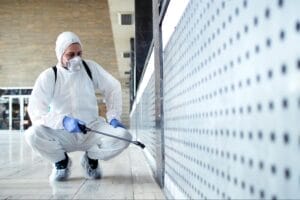The mold that develops as a result of water damage can vary widely in appearance, depending on the type of mold and the surface it grows. Typically, mold appears as discolored patches on walls, ceilings, or other surfaces. These patches can range from black, green, or gray to white or even orange.
The texture of mold can also vary; it might appear fuzzy, velvety, or slimy. Often, mold growth is accompanied by a musty or earthy odor, which can be a strong indicator of its presence even before visible signs appear.
Common Types of Indoor Mold
Alternaria
Alternaria is a common indoor mold that appears dark green or brown with a velvet texture. It often grows in damp areas like showers, sinks, and around windows. Remediation involves fixing moisture issues and using mold-killing products.
Acremonium
Acremonium starts as a small moist mold that turns into a powdery substance over time. It is typically found in humidifiers, cooling coils, and drain pans. Remediation requires eliminating the source of moisture and possibly replacing affected materials.
Aureobasidium
Aureobasidium mold appears pink, brown, or black and grows on painted surfaces, wooden furniture, and wallpaper. It can spread rapidly if not addressed promptly. Remediation involves scrubbing the affected area with a mold cleaner and ensuring proper ventilation.
Chaetomium
Chaetomium mold appears white at first and later turns gray, then black. It thrives in water-damaged materials like drywall and window frames. Remediation includes removing and replacing the affected materials and addressing the moisture source.
Cladosporium
Cladosporium mold is green, brown, or black and typically grows on fabrics, carpets, and wooden surfaces. It can cause health issues such as asthma and hay fever symptoms. Remediation involves cleaning with a fungicidal solution and improving ventilation.
Fusarium
Fusarium mold appears white, pink, or red and can grow at lower temperatures than other molds. It is commonly found on water-damaged carpets and wallpaper. Remediation includes drying affected areas thoroughly and using mold-killing agents.
Stachybotrys Atra (Black Mold)
Stachybotrys Atra, often referred to as black mold, is dark greenish-black and slimy. It grows on materials with high cellulose content like wood and paper. Remediation involves professional mold removal due to its potential health risks.
Mucor
Mucor mold is white or gray and spreads quickly over organic materials. It thrives in areas with high humidity levels and poor ventilation. Remediation includes drying affected areas, removing moldy materials, and improving ventilation.
Aspergillus
Aspergillus mold can appear in various colors such as green, yellow, or white. It is commonly found on foods and in air conditioning systems. Remediation involves fixing moisture issues and cleaning affected areas with mold-killing solutions.
Penicillium
Penicillium mold is blue or green and often grows on water-damaged materials such as carpets, wallpaper, and insulation. It can cause respiratory issues and allergic reactions. Remediation includes removing affected materials and improving ventilation.
Trichoderma
Trichoderma mold is white with patches of green or gray. It thrives on damp surfaces like wallpaper and damp drywall. Remediation involves removing and replacing affected materials and addressing the underlying moisture problem.
Ulocladium
Ulocladium mold is black and grows in areas with high humidity and water damage, such as basements and bathrooms. It can cause respiratory problems and allergies. Remediation includes drying the affected area and using mold-killing products.

Identifying Mold From Water Damage
Identifying mold from water damage involves recognizing visual cues and understanding where mold commonly grows after water intrusion. Look for discoloration, musty odors, and damp areas such as basements, bathrooms, and around windows and pipes.
Health Risks Associated With Mold
Mold exposure can lead to allergies, respiratory issues, and more severe health effects in vulnerable individuals such as children, the elderly, and those with compromised immune systems. Prompt remediation is essential to prevent health complications.
Steps to Take If You Discover Mold
- Immediately address water leaks or moisture issues.
- Remove and discard moldy materials that cannot be cleaned.
- Clean mold-infested areas with mold-killing products.
- Improve ventilation and reduce humidity levels.
- Consider hiring a professional mold remediation service for extensive mold problems.
How Quickly Can Mold Grow From Water Damage
Mold can start growing within 24 to 48 hours after water damage occurs. Rapid response to water leaks and moisture issues is crucial to prevent mold growth and the need for extensive remediation. For more information on preventing mold after water damage, check out our guide on How Quickly Can Mold Grow From Water Damage.




